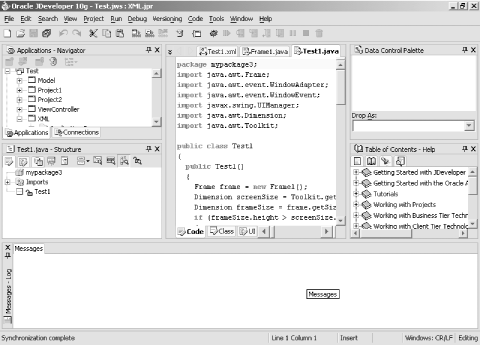8.2 Development Tools
| Writing programs in Java can be accomplished with something as simple as your favorite text editor and the javac compiler. However, developing business applications with Java (or any other language, for that matter) requires a host of tools and technologies. To simplify management of the tools and technologies required for application development, and at the same time improve the efficiency of the development staff, IDEs were created. An IDE combines a modeling tool, text editor, compiler, make utility, deployment tool, and so on, into one application that seamlessly integrates the use of each tool with the next during the development life cycle. As you will see shortly, many IDE vendors provide support for Oracle Application Server, typically as a deployment destination. 8.2.1 Oracle JDeveloperOracle JDeveloper is Oracle's IDE for Java. Oracle JDeveloper, an excellent IDE in its own right, is tightly integrated with Oracle Application Server. Because it is so tightly integrated, this section will spend a little time providing an overview of this tool. 8.2.1.1 IDEOracle JDeveloper is a J2EE, XML, and PL/SQL development environment that supports the full development life cycle, from modeling a business solution through its deployment. The IDE itself is extensible, so other development tools and technologies can be added to the environment as needed. Oracle JDeveloper provides tools for source code control, data and object modeling, coding, debugging, profiling, and deployment. The editor does both syntactic and semantic verification of your code as it is entered. It also provides context-sensitive help in the form of access to API documentation. Many complex or mundane programming tasks are simplified with the use of wizards. Figure 8-3 shows a typical Oracle JDeveloper screen setup. The smaller window sections are called dockable windows . You select the dockable windows you desire from the view menu. Displayed in this figure are the Application Navigator, Class Structure, Data Control Panel, Help, Editor, and Error Message windows. Figure 8-3. An example of the Oracle JDeveloper IDE's GUI Oracle JDeveloper can build J2EE and/or XML applications or Web Services that can be deployed onto any J2EE server. However, Oracle JDeveloper is also tightly integrated with Oracle Application Server through its Application Development Frameworks that use OracleAS Business Components for Java and OracleAS TopLink. 8.2.1.2 Application Development FrameworkOracle JDeveloper's Application Development Framework (ADF) allows you to use several combinations of technologies to build web applications. ADF leverages the Open Source, Model 2, MVC implementation, Struts. Using Struts as the controller, ADF employs combinations of other technologies for the model and view, such as:
8.2.1.3 OracleAS Business Components for JavaOracleAS Business Components for Java, or ADF Business Components as it is known in Oracle JDeveloper, is an application framework that implements common design patterns. OracleAS Business Components for Java expands on the standard J2EE by providing solutions for data access, network traffic minimization, object-relational mapping, validation, and user -interface data binding. OracleAS Business Components for Java applications are deployable on any application server. Oracle Enterprise Manager's Application Server Control tool is an example of an application that uses OracleAS Business Components for Java. 8.2.1.4 TopLinkOracleAS TopLink is an advanced object-relational mapping tool that some may say resides in the same solution space as EJB QL and JDO. However, unlike these technologies, OracleAS TopLink makes mapping relational database architecture to Java's object-oriented architecture easy by providing a superior mapping tool called the Mapping Workbench. [1] With OracleAS TopLink, it's possible to persist any Java object in any relational database that is also supported by a JDBC 2.0 driver.
OracleAS TopLink's graphical mapping tool, Mapping Workbench, presents relational databases with an object-oriented view. This means that Java programmers with no SQL experience can map Java classes into a relational database structure. OracleAS TopLink is extremely flexible. It can map JavaBeans as well as EJBs to a relational database. It supports the mapping of both container-managed persistence and bean-managed persistence EJBs. OracleAS TopLink even supports mapping in a Java Client two- tier application. 8.2.2 Third-Party SupportMany of today's top IDEs provide support for Oracle Application Server. In addition, other products exist that extend the capabilities of Oracle Application Server. The following is a short list of third-party IDEs that support Oracle Application Server deployment:
Because a list such as this can change dramatically over time, it's best if you consult it online. You can find an up-to-date list at http://otn.oracle.com/products/ias/9ias_partners.html. As discussed earlier in Chapter 6, you can even code directly in a deployment directory on the server. In this configuration, you can simply use your favorite text editor and the Sun JDK's javac compiler to build your application. |
EAN: 2147483647
Pages: 120